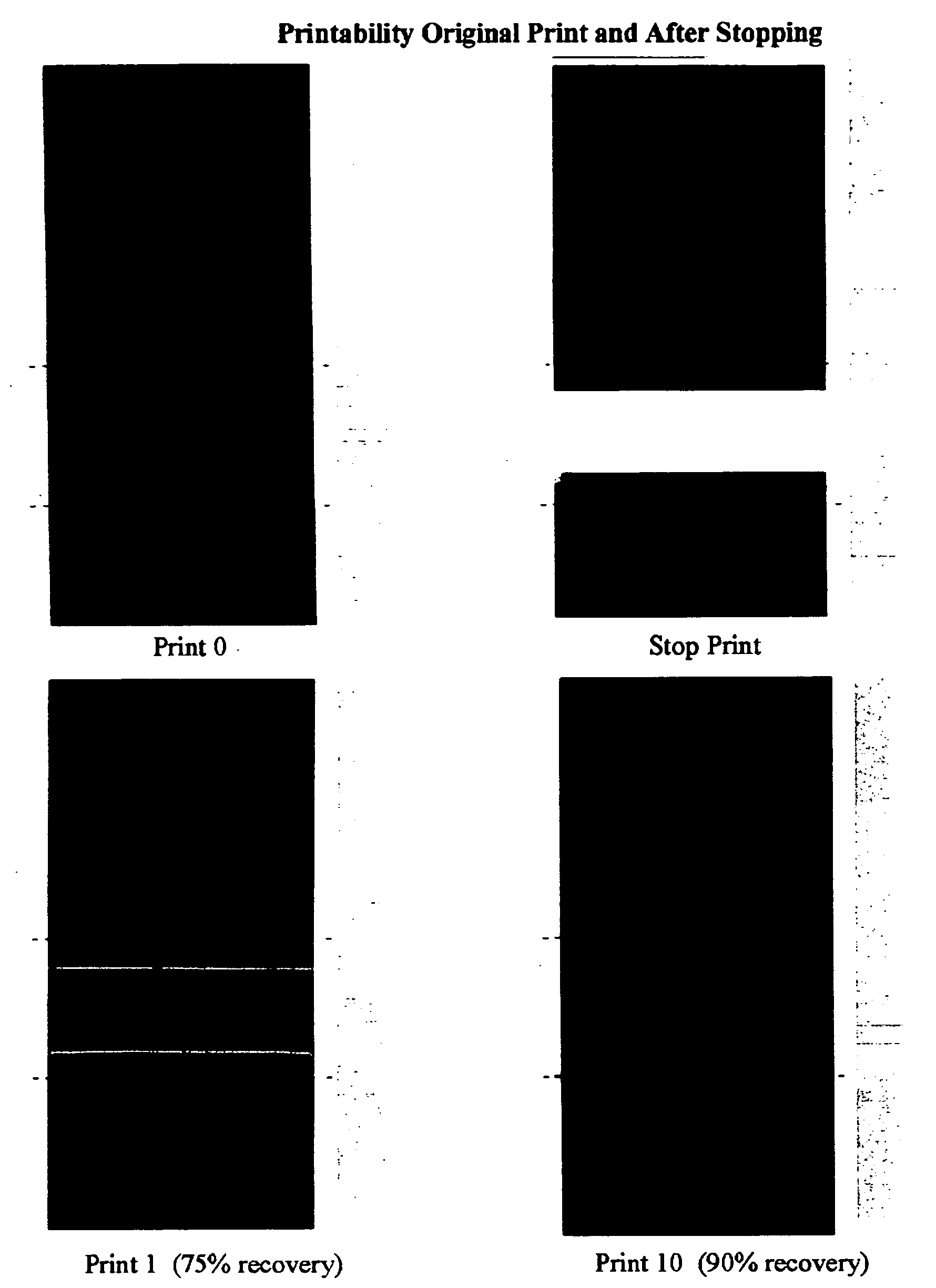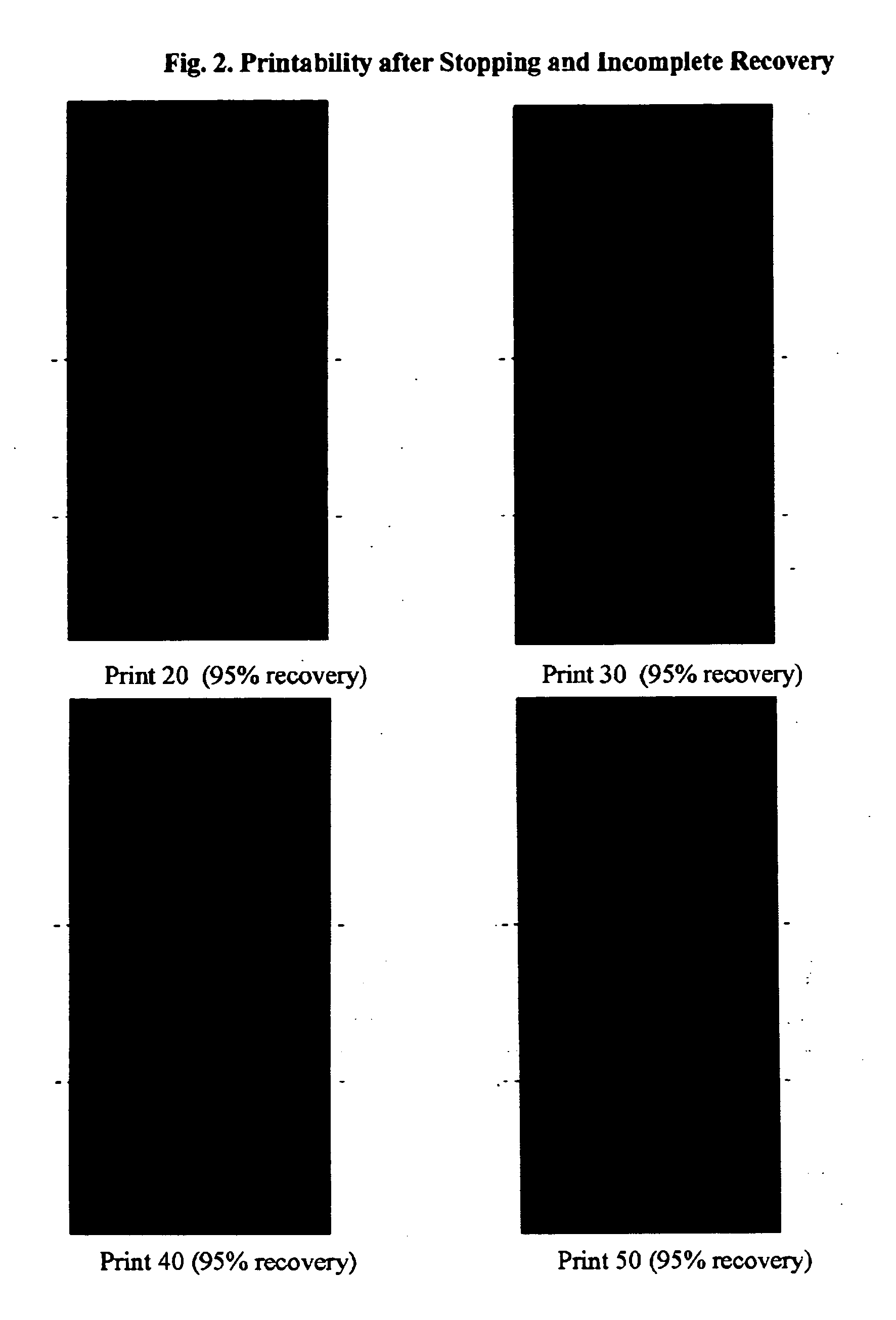Emulsion compositions for use in printing inks
a technology of emulsion compositions and printing inks, applied in the direction of organic dyes, coatings, inks, etc., can solve the problems of inability to bind to the substrate, so as to prevent premature crosslinking and promote storage stability
- Summary
- Abstract
- Description
- Claims
- Application Information
AI Technical Summary
Benefits of technology
Problems solved by technology
Method used
Image
Examples
example 1
Preparation of Support Polymers
[0052] The support polymer compositions given in Table 1 were prepared using a continuous polymerization process as described in U.S. Pat. Nos. 4,546,160; 4,414,370; and 4,529,787, the entire disclosures of which are incorporated herein by reference Unless otherwise stated, the numbers in Table 1 represent weight percent.
TABLE 1Support Polymers (SP)SP-1SP-2SP-3SP-4COMPONENTSAcrylic Acid10.520.034.433.6Butyl Acrylate32.425.4alpha-Methyl Styrene0.039.131.535.6Styrene16.715.534.125Methacrylic Acid12.5n-Butyl Methacrylate27.92-Ethyl hexylacrylate5.8TOTAL100.0100.0100.0100.0PROCESS CONDITIONSReactor Temperature (° C.)207210212217Residence Time (min.)12121212MOLECULAR WEIGHTSMw62506800100009000Mn2400350032003000Acid Number144140215220(mg KOH / g polymer)Oxygen Content2315.714.815.1(wt. % of polymer)Tg (° C.)2989123117
example 2
Preparation of Emulsion Polymers Using Support Polymers
[0053] Emulsion polymers given in Table 2 were prepared from polymer particles polymerized in the presence of the support polymers of Table 1. A solution of support polymer, ammonia (25%) and de-ionized (DI) water was brought to 85° C. in a 2L 4-neck round bottom flask under a mild flow of nitrogen. A mixture of monomers was prepared and charged to the reactor. Next, ammonium persulfate (APS) dissolved in deionized (DI) water was charged to the reactor. After 15 minutes, the remaining monomer mixture was supplied to the reactor over 45-60 minutes. During the process, the temperature remained at 85° C. After this, the reactor contents remained under these conditions for 60 minutes to reduce residual monomer content. After this hold-period, the emulsion was cooled and adipic dihydrazide was added if used in the formula. The emulsion was mixed for an additional 15 minutes and subsequently filtered. Unless otherwise stated, the num...
example 3
Evaluation of Inks Made from Emulsions of Example 2
[0054] From the emulsions of Example 2, inks were prepared by blending 60 parts emulsion polymer with 30 parts of a phthalocyanine blue pigment concentrate (PC), 5 parts of JONWAX™ 35 (wax emulsion, JOHNSON POLYMER LLC, Sturtevant, Wis.) and 5 parts of iso-propanol. For all inks an additional 5 parts of BACOTE 20 was added. The pigment concentrate (PC) was made from 30 wt. % of JONCRYL™ 690 (pigment dispersant resin, JOHNSON POLYMER LLC, Sturtevant, Wis.), 35 wt. % of phthalocyanine blue 15:3, 1 wt. % of TEGO FOAMEX™ 805 (anti-foam agent, TEGO Chemie) and 34 wt. % DI water. Selected properties of the inks are given in Table 3.
TABLE 3Properties of InksEmulsionDryingDryWetWetWetWetInkPolymer in InkConditionAdhesionAdhesionRubSATRACrinkleI-2EP-2B555100 / 954I-4EP-4A51110 / 01I-4EP-4B554.5100 / 801.5I-5EP-5A4.53310 / 01I-5EP-5B555100 / 954I-6EP-6A51110 / 01I-6EP-6B555100 / 201.5I-5 / 4 AEP-5:EP-4B555200 / 0 4.5 / 5(70:30 ratio)I-5 / 6 AEP-5:EP-6B555200 / 0 ...
PUM
| Property | Measurement | Unit |
|---|---|---|
| glass transition temperature | aaaaa | aaaaa |
| wt. % | aaaaa | aaaaa |
| glass transition temperature | aaaaa | aaaaa |
Abstract
Description
Claims
Application Information
 Login to View More
Login to View More - R&D
- Intellectual Property
- Life Sciences
- Materials
- Tech Scout
- Unparalleled Data Quality
- Higher Quality Content
- 60% Fewer Hallucinations
Browse by: Latest US Patents, China's latest patents, Technical Efficacy Thesaurus, Application Domain, Technology Topic, Popular Technical Reports.
© 2025 PatSnap. All rights reserved.Legal|Privacy policy|Modern Slavery Act Transparency Statement|Sitemap|About US| Contact US: help@patsnap.com



